- Home
- Georgette Heyer
Jennifer Kloester Page 11
Jennifer Kloester Read online
Page 11
White’s club (37 St James’s Street) was established in 1697 and remains the oldest club in London. Originally opened by Francis White in 1693 as White’s Chocolate House, it occupied several locations in St James’s Street, including the site of what is now Boodle’s. From its inception, White’s attracted the cream of England’s upper class although neither wit, wealth nor birth guaranteed one’s election to the club. Members were elected by ballot in which at least twelve clubmen had to participate by dropping either a white ball, signifying approval, or a black ball to indicate exclusion. A single black ball was all it took to deny a man admission to the club. White’s flourished during the Regency and was renowned as the ‘home of the dandies’ with a dandy set led by Beau Brummell, elected a member in 1789. White’s was also, for a time, a Tory stronghold—although men of both parties continued as members—but after 1832 it became apolitical. As Peregrine Taverner in Regency Buck was aware, membership of White’s bestowed a certain distinction on a man and was an honour coveted by many among the upper class which made it a great relief when his guardian, the Earl of Worth, agreed to have him made a member.
Beau Brummell was one of the most famous members of White’s club where he made the bow-window his particular preserve.
Established in 1762, Boodle’s (28 St James’s Street) had originally been started as a club at 50 Pall Mall by William Almack, the founder of Almack’s. Originally known as the ‘Savoir Vivre’ it was eventually named after the manager Edward Boodle. In later years Boodle’s moved into a fine Adam-style building in St James’s Street on the original site of White’s club. Although it was a political club at its inception, Boodle’s shed its political inclinations early on and its members were content to gamble, partake of fine food, sit in the bow-window and enjoy the club’s calm and uneventful environment. Boodle’s was one of the clubs to which Lord Lionel Ware went to hear the gossip about his son and nephew in The Foundling.
Established in 1764, just two years after Boodle’s, Brooks’s (60 St James’s Street) was another of William Almack’s early clubs and was located for a time at 49 Pall Mall, next to the original Boodle’s site. Initially, it was a club inside a tavern until the members agreed to employ William Brooks to manage it and the club soon took on his name. Like White’s, Brooks’s was well known for its high-stakes gambling and during the Regency many fortunes exchanged hands at the tables in Brooks’s Great Subscription Room. Originally a young man’s club, and a meeting place for men of no particular political persuasion, by the end of the eighteenth century Brooks’s had become a noted Whig stronghold with the great orator and hedonist, Charles James Fox, as its leader. Fox’s death in 1806 did nothing to diminish the club’s Whiggish bent and many of the club’s noble members sat on the Opposition benches in the House of Lords although some, such as Adam Deveril of A Civil Contract, had Tory leanings but remained members of Brooks’s out of respect for their family tradition.
Watier’s (81 Piccadilly) appears to have been established originally as a venue for harmonic meetings but, in 1807, the Prince of Wales invited his chef Watier to start a club which would provide a cuisine superior to the more mundane fare offered at White’s or Brooks’s. Watier took over the rooms at 81 Piccadilly and offered such magnificent food that the club quickly became the talk of the town, drawing to it all the well-born young bucks and bloods of the day who initiated the high play and wild gambling for which Watier’s soon became notorious. Known as the ‘Great-Go’ and called by Byron ‘the Dandy Club’, Watier’s attracted members who were mostly men of fashion addicted to gaming and ready to throw a fortune away on a brief moment of chance. In April Lady, Watier’s was a favourite haunt of Nell Cardross’s pleasure-loving brother, Dysart, who enjoyed the fine dinners and high play. Beau Brummell was designated the club’s perpetual president until 1816 when his debts forced him into exile in France, and by 1819 most of the club’s leading members had sustained such enormous gambling losses that Watier’s closed its doors for ever.
The clubs made it easy for any well-bred man—whether married or single—to spend time away from home, and wives, sisters, mothers and daughters frequently accepted men’s need to escape from their female relatives from time to time. It was tacitly understood by many women that, in order to retain any respect for their menfolk, it was essential either to feign ignorance or to refrain from discovering exactly what men did do when they had escaped. Alcohol was an accepted part of Regency life and all classes imbibed huge quantities of wine, spirits and ale, the latter often drunk at breakfast. Among the upper class Madeira, sherry and brandy were the drinks of preference throughout the day and into the evening, while port was generally reserved as an after-dinner drink. Sir Richard Wyndham in The Corinthian imbibed a large enough quantity of brandy to become quite drunk the night before his planned proposal to the aristocratic Melissa Brandon, and on leaving the club felt compelled to go for a long walk to clear his head. Drunkenness was common, particularly among young men for whom it was deemed an acceptable condition. Enthusiastic youths bent on having fun, and possibly in London for the first time, could think of no occupation more desirable than to throw off a third of daffy (gin) at Limmer’s Hotel in the company of the fancy, or to drink beer while mixing with the sporting set at Cribb’s Parlour. To engage in a revel-rout or wine party and spend the night carousing, engaging in pranks (such as boxing the watch) and finishing the night in the watch-house was, for some, the height of ambition.
Other less salubrious venues popular with men during the Regency were the Daffy Club (a pugilistic setting), the Cock-pit Royal in Birdcage Walk, the Royal Saloon in Piccadilly, the Peerless Pool, and the Westminster Pit where men of all classes gathered to watch dog-fights. Boxing enthusiasts such as Sir Waldo Hawkridge in The Nonesuch or the Marquis of Alverstoke in Frederica could take themselves off to Gentleman John Jackson’s Boxing Saloon at 13 Bond Street where athletic men of fashion (known as Corinthians) could take lessons from the great man himself. Devotees of pugilism generally revered Jackson and eagerly attended his sparring matches at the Fives Court in London or the illicit bouts between the pets of the fancy which were usually set up within a couple of hours’ drive of the city.
Even those entertainments which men and women could enjoy together, such as the theatre, music and the opera, had an exclusively masculine side to them. Strolling in Fops’ Alley (the walkway between the pit and the stalls) at the opera, or lingering to admire the prostitutes known as Cyprians in the saloon at Covent Garden, was considered famous sport, while flirting with opera dancers or ogling the ladies in the audience were activities to which a man’s female companions were expected to turn a blind eye as Hero quickly learned in Friday’s Child. In addition to the theatre, concerts, opera, soirées, balls, parties and assemblies which were the usual evening activities for the ton, Regency men would often seek out the grog shops and brothels of Tothill Fields where they could drink quantities of cheaply distilled spirits and become blind drunk for just a few pence, or have their way with a prostitute for not much more. All the pleasures of the flesh were available to a man with money, and the elasticity of upper-class morality during the Regency meant that there was little that he could not do. For some, however—such as the Honourable Beverley Brandon in The Corinthian—years of debauched and dissipated living left them both financially and morally bankrupt.
THE BOW-WINDOW SET
So famous was the bow-window at White’s club that Sophy Stanton-Lacy in The Grand Sophy dared to drive down the exclusive male precinct of St James’s Street in her high-perch phaeton in the hopes of seeing it. The bow-window came into existence in the first year of the Regency. For the club, 1811 was a year of change with the entrance fee doubled from ten to twenty guineas and subscriptions raised to eleven guineas. It was at this time, too, that the original front entrance was moved from the centre of the front façade to its present position nearer to the southern end of the building, with a new entrance created by converting the second windo
w into a door. Where the old entrance had stood, a bow-window was built above the original steps into the club and this and the old entrance hall together served to enlarge the morning room. A new Master of the House, in the person of the efficient Mr Raggett, took over in 1812 and it was at about this time that George Bryan ‘Beau’ Brummell made the window his domain. In company with three of the noted dandies of the day, Lord Alvanley, Sir Henry Mildmay and Henry Pierrepoint, he would sit in the window where, as the leader of the ‘Unique Four’, he would freely discuss those passing by. The Earl of Worth, hero of Regency Buck, belonged to Brummell’s set and was one of those who famously adhered to the Beau’s rule that no one sitting in the bow-window should ever acknowledge a greeting from the street. So great was Brummell’s influence that no ordinary member of White’s would ever have dared to sit in the Holy of Holies!
VAUXHALL GARDENS
First opened as the ‘New Spring Gardens’ in 1660 on a twelve-acre site near Lambeth on the south side of the Thames, Vauxhall Gardens was originally a landscaped public garden with an orchard, long walks, arbours and hedges. Referred to by the great diarist Samuel Pepys as ‘Fox Hall’, the site had originally been that of a house built in the reign of King John known as Vauke’s Hall—hence Vauxhall. In 1728, Jonathan Tyers leased the old Spring Garden and completely redesigned the site, establishing tree-lined promenades and putting in gravel paths, fountains, artificial ruins, illuminated transparencies, statues, platforms for musicians, and lighting the whole with a thousand lanterns. A pavilion, a rotunda and supper-boxes provided places to sit and eat, to dance, watch the passers-by or listen to the orchestra.
Visitors could reach Vauxhall either by crossing the Thames in a boat and passing through the water entrance, as Mr Beaumaris’s guests did in Arabella, or by way of Westminster Bridge and Kennington Road and there to the lane that gave access to the land entrance. The gardens were enormously popular and open to all classes of society, but between April and June they became the particular pleasure haunt of the upper class. It cost three shillings to enter Vauxhall where visitors could marvel at the many thousands of lamps illuminating the gardens, hanging in festoons from the trees and between the cast-iron pillars of the vaulted colonnade. They could wander the walkways, watch the fireworks or the mechanical Cascade which so delighted Arabella, dance, or even sing along with one of the bands placed around the gardens. Pandean minstrels entertained the guests and an orchestra gave a two-part concert in the rotunda each evening at eight o’clock. Masquerades, ridottos, performances by famous singers and gala nights continued at Vauxhall throughout the Regency. It was a favourite haunt of the Prince Regent and in 1813 he was host at a grand fête to celebrate the Battle of Vittoria. The gala event drew such vast numbers that many of them did not get into the gardens at all due to the press of people and carriages outside. In 1814 a naumachia or sea-battle enactment was presented in the gardens and, in 1816, the famous Parisienne acrobat Madame Saqui, adorned with spangles and feathers, enthralled her audience with her rope dancing and tightrope walking. Vauxhall was also famous for its wafer-thin slices of ham and its intoxicating arrack-punch which could be bought for eight shillings a quart but which was notoriously potent. In Friday’s Child Lord Sheringham took his new bride to Vauxhall for the evening soon after their wedding, and the young couple thoroughly enjoyed the dancing, fireworks and the famous supper. More than a hundred supper-boxes were available for hire, many of them still decorated with eighteenth-century paintings by William Hogarth and Francis Hayman, and each holding six or eight guests. Waiters attended the boxes and guests could order chicken or ham, mix their own salads, sip on burnt-wine or blend their own brew of arrack-punch. The Regency witnessed the last great phase of Vauxhall’s popularity and the gardens eventually closed in 1859.
Vauxhall Gardens was the place to see and be seen during the Regency.
LADIES OF THE NIGHT, BROTHELS AND GAMBLING HELLS
As in every age, prostitution was rife during the Regency. From the high-class courtesan to the streetwalker, women were available to satisfy the lusts of even the most amorous, debauched or hedonistic man. Although they could be found across the city, one of the best-known areas for prostitutes was that comprising the streets and lanes around Covent Garden, also known as the ‘stews’. Here, certain inns and taverns were notorious for their sexual offerings and were known to be visited by fashionable women as well as men. The theatres, too, were popular with the Cyprians who could be seen parading their wares in the foyers and the green rooms of Covent Garden and Drury Lane. A box at the Royal Opera House was a favoured venue for those courtesans wanting to display their attributes or throw out a lure to a possible paramour. In Friday’s Child, the incorrigible Lord Sheringham took his wife to a Covent Garden masquerade where he enjoyed pursuing a masked female or ‘bit of muslin’ who he was sure was an old paramour known as Flyaway Nancy. For those among the ‘Fashionable Impures’ who won the favour of an affluent gentleman it meant a life of wealth, luxury and indulgence for as long as they held his favour. To win carte blanche from a lover was the ultimate aim but the harsh reality for many of the women and girls selling themselves on the street was that it was about survival more than luxury or comfort.
Brothels operated across the city and some former courtesans went into business for themselves, running high-class bordellos in elegantly decorated houses and using their wiles, or even a little blackmail, to draw former lovers to their rooms. In Black Sheep, Miles Calverleigh sought out an old acquaintance who had risen from the ranks of the Cyprians to become the proprietor of a high-class brothel. Dolly (once known as ‘the Dasher’), having been funded by a rich lover, drove a stylish barouche in Hyde Park and carried herself like one of the aristocracy—although she was always willing to oblige an old friend. One of the most famous brothels of the Regency was the White House in Soho Square, formerly an aristocratic mansion before its conversion into a house of ill-repute. It was a large, square building of many rooms, each of which was individually decorated and named according to its style, including the Grotto, the Coal Hole, the Skeleton Room, the Painted Chamber and the Gold, Silver and Bronze Rooms. The house was splendidly decorated with mirrors embedded in the walls and an array of accessories—both mechanical and manual—to gratify the most lascivious visitor. Elegant brothels existed throughout Mayfair and the West End, often standing cheek by jowl with the homes of London’s most respectable citizens. Many brothels, though, were simply squalid rooms where pimps and procuresses sold the services of those enslaved to them, and every kind of sexual desire could be gratified for a price.
The other great temptation for men and women drawn to the seamier side of Regency life were the gambling hells. These were often run as ‘clubs’ and were open to anyone with money to bet on the roll of the dice or the turn of a card. They were especially popular with those gentlemen refused admittance to the more reputable clubs of St James’s such as White’s, Brooks’s and Boodle’s, and many of the hells were set up in the St James’s and Pall Mall area. By 1820 more than two dozen gambling hells were operating in this part of London with houses in Jermyn, King, Bury and Bennett Streets as well as at 4 Pickering Place (Peregrine Taverner in Regency Buck gambled at a hell at number 5), 12 Park Place, 3 Cleveland Row and at numbers 6, 32, 55, 58 and 71 Pall Mall among the best-known. The gambling hell in Bennett Street was also known as ‘the Dandy House’ and was popular among officers of the Guards and the fashionable men of the day who enjoyed the elegant suppers and high play. The stakes in most hells usually ranged from 5s. to £100, but almost any amount could be covered if a player was confident, or desperate, enough. Many of the hells were notorious for drawing in young, inexperienced players and letting them win before turning the luck in favour of the bank, by which time the gambler was usually caught up by the excitement of winning or, later, the need to recover from his losses. Bertram Tallant in Arabella was delighted by the amazing run of luck which he enjoyed on his first night at a ‘discreet
house in Pall Mall’ and felt sure his friend Felix Scunthorpe’s dire warnings about sharps and loaded dice had been quite wrong. The elegant surroundings of the gambling hells of St James’s and Pall Mall were often a cover for the ruthless play and unfair practices of the houses, which were frequented not only by the rich and fashionable, the clergy and the nobility, but also by cheats and swindlers known as ‘black-legs’, ‘Captain Sharps’ or ‘ivory-turners’.
Ivory-turners were so-called because of their ability to make the dice (ivories) ‘turn’ to the numbers they needed to win the game. Dice cheats generally used loaded or ‘cogged’ dice—known during the Regency as ‘fulhams’ from the town of Fulham where they were originally made (it also sounded appropriately like ‘fool ’em’). Loaded dice were specially made to roll in favour of particular numbers, with those rolling towards the high numbers known as ‘uphills’ and those rolling to the lower numbers called ‘downhills’. Some false dice had only three numbers instead of the usual six, with two sides each with four, five and six pips. These were known as ‘dispatchers’ for their ability to dispatch a man’s money from his pocket with great efficiency. Gambling cheats were known also as sharks, sharps and sometimes as ‘Greeks’, but the beautiful Olivia Broughty in Cotillion assured Kitty Charing that in the best gaming houses Greeking methods were only used as a last resort and loaded dice never! Card-sharps usually cheated by changing the pack (known as fuzzing the cards), marking cards or hiding winning cards or hands up their sleeves or on their person. Sharps and ivory-turners mostly operated in the gambling dens and hells around Pall Mall and St James’s, although they sometimes arranged private games with unsuspecting or gullible men (known as ‘flats’) whose trusting and naive demeanour made them easy to dupe.

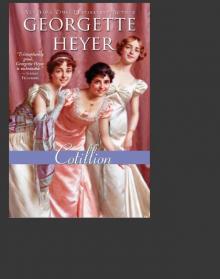 Cotillion
Cotillion Frederica
Frederica The Black Moth: A Romance of the XVIIIth Century
The Black Moth: A Romance of the XVIIIth Century Lady of Quality
Lady of Quality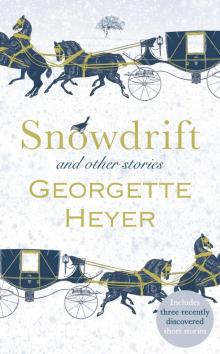 Snowdrift and Other Stories
Snowdrift and Other Stories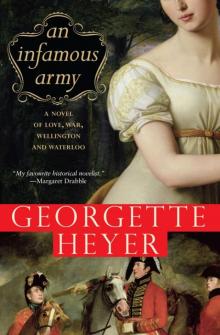 An Infamous Army
An Infamous Army The Talisman Ring
The Talisman Ring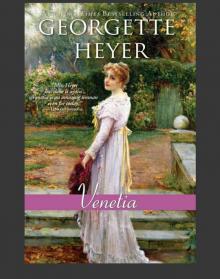 Venetia
Venetia The Quiet Gentleman
The Quiet Gentleman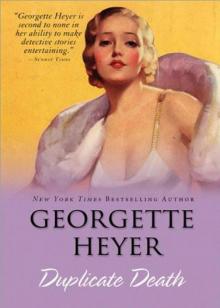 Duplicate Death
Duplicate Death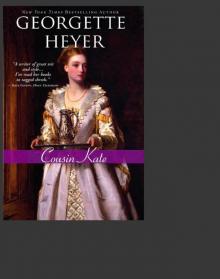 Cousin Kate
Cousin Kate Black Sheep
Black Sheep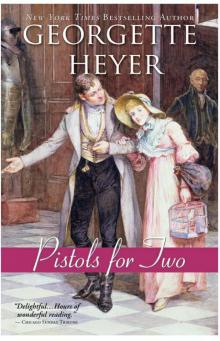 Pistols for Two
Pistols for Two Sprig Muslin
Sprig Muslin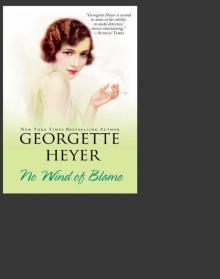 No Wind of Blame
No Wind of Blame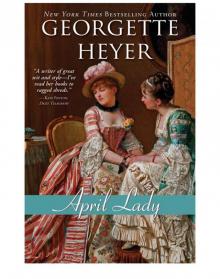 April Lady
April Lady False Colours
False Colours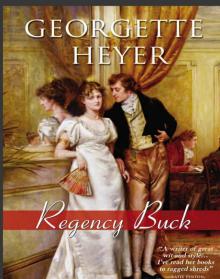 Regency Buck
Regency Buck The Toll-Gate
The Toll-Gate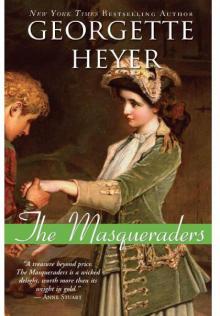 The Masqueraders
The Masqueraders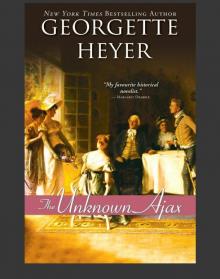 The Unknown Ajax
The Unknown Ajax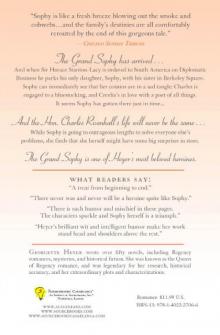 The Grand Sophy
The Grand Sophy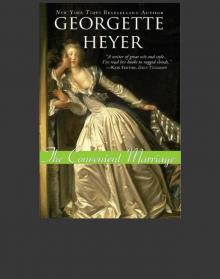 The Convenient Marriage
The Convenient Marriage Faro's Daughter
Faro's Daughter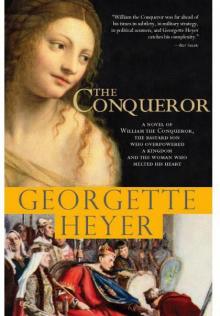 The Conqueror
The Conqueror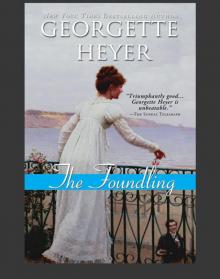 The Foundling
The Foundling The Black Moth
The Black Moth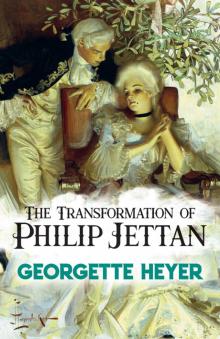 The Transformation of Philip Jettan
The Transformation of Philip Jettan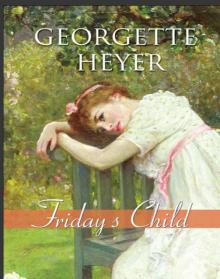 Friday's Child
Friday's Child Beauvallet
Beauvallet They Found Him Dead
They Found Him Dead Charity Girl
Charity Girl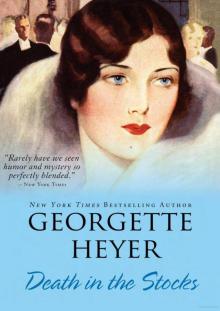 Death in the Stocks: Merely Murder
Death in the Stocks: Merely Murder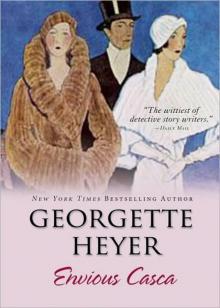 Envious Casca
Envious Casca Behold, Here's Poison
Behold, Here's Poison Arabella
Arabella The Nonesuch
The Nonesuch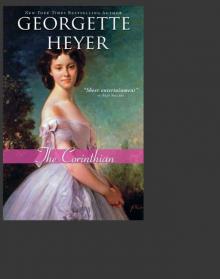 The Corinthian
The Corinthian Jennifer Kloester
Jennifer Kloester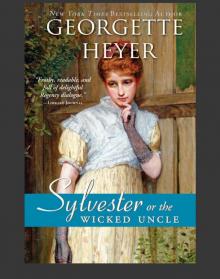 Sylvester
Sylvester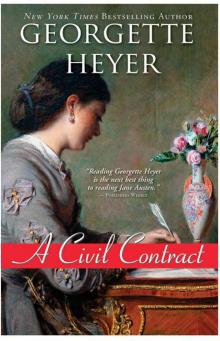 A Civil Contract
A Civil Contract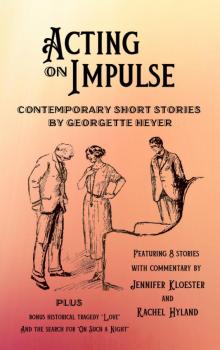 Acting on Impulse
Acting on Impulse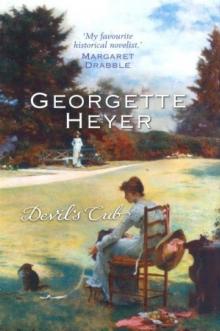 Devil’s Cub at-2
Devil’s Cub at-2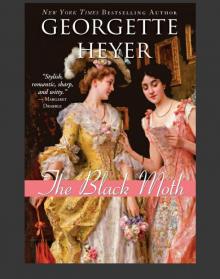 Black Moth
Black Moth Grand Sophy
Grand Sophy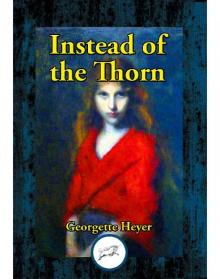 Instead of the Thorn
Instead of the Thorn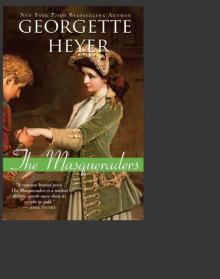 Masqueraders
Masqueraders Corinthian
Corinthian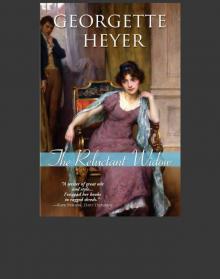 Reluctant Widow
Reluctant Widow